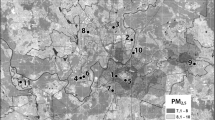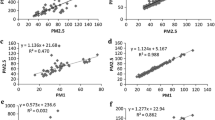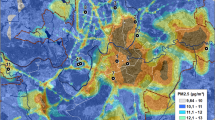Abstract
Background, Aim and Scope
The impact of air pollution on school children’s health is currently one of the key foci of international and national agencies. Of particular concern are ultrafine particles which are emitted in large quantities, contain large concentrations of toxins and are deposited deeply in the respiratory tract.
Materials and methods
In this study, an intensive sampling campaign of indoor and outdoor airborne particulate matter was carried out in a primary school in February 2006 to investigate indoor and outdoor particle number (PN) and mass concentrations (PM2.5), and particle size distribution, and to evaluate the influence of outdoor air pollution on the indoor air.
Results
For outdoor PN and PM2.5, early morning and late afternoon peaks were observed on weekdays, which are consistent with traffic rush hours, indicating the predominant effect of vehicular emissions. However, the temporal variations of outdoor PM2.5 and PN concentrations occasionally showed extremely high peaks, mainly due to human activities such as cigarette smoking and the operation of mower near the sampling site. The indoor PM2.5 level was mainly affected by the outdoor PM2.5 (r = 0.68, p < 0.01), whereas the indoor PN concentration had some association with outdoor PN values (r = 0.66, p < 0.01) even though the indoor PN concentration was occasionally influenced by indoor sources, such as cooking, cleaning and floor polishing activities. Correlation analysis indicated that the outdoor PM2.5 was inversely correlated with the indoor to outdoor PM2.5 ratio (I/O ratio; r = −0.49, p < 0.01), while the indoor PN had a weak correlation with the I/O ratio for PN (r = 0.34, p < 0.01).
Discussion and conclusions
The results showed that occupancy did not cause any major changes to the modal structure of particle number and size distribution, even though the I/O ratio was different for different size classes. The I/O curves had a maximum value for particles with diameters of 100–400 nm under both occupied and unoccupied scenarios, whereas no significant difference in I/O ratio for PM2.5 was observed between occupied and unoccupied conditions. Inspection of the size-resolved I/O ratios in the preschool centre and the classroom suggested that the I/O ratio in the preschool centre was the highest for accumulation mode particles at 600 nm after school hours, whereas the average I/O ratios of both nucleation mode and accumulation mode particles in the classroom were much lower than those of Aitken mode particles.
Recommendations and perspectives
The findings obtained in this study are useful for epidemiological studies to estimate the total personal exposure of children, and to develop appropriate control strategies for minimising the adverse health effects on school children.






Similar content being viewed by others
References
Afshari A, Matson U, Ekberg LE (2005) Characterization of indoor sources of fine and ultrafine particles: a study conducted in a full-scale chamber. Indoor Air 15:141–150
Andersen ZJ, Wahlin P, Raaschou-Nielsen O, Ketzel M, Scheike T, Loft S (2008) Size distribution and total number concentration of ultrafine and accumulation mode particles and hospital admissions in children and the elderly in Copenhagen, Denmark. Occup Environ Med 65(7):458–466
Annesi-Maesano I, Moreau D, Caillaud D, Lavaud F, Le Moullec Y, Taytard A, Pauli G, Charpin D (2007) Residential proximity fine particles related to allergic sensitisation and asthma in primary school children. Respir Med 101(8):1721–1729
Baron PA, Willeke K (2001) Aerosol measurement: principles, techniques, and applications, 2nd edn. Wiley, New York
Blondeau P, Lordache V, Poupard O, Genin D, Allard F (2004) Relationship between outdoor and indoor air quality in eight French schools. Indoor Air 15:2–12
Branis M, Rezacova M, Domasova M (2005) The effect of outdoor air and indoor human activity on mass concentrations of PM10, PM2.5, and PM1 in a classroom. Environ Res 99(2):143–149
Branis M, Safranek J, Hytychova A (2009) Exposure of children to airborne particulate matter of different size fractions during indoor physical education at school. Build Environ 44(6):1246–1252
Chao CYH, Wan MP, Cheng ECK (2003) Penetration coefficient and deposition rate as a function of particle size in non-smoking naturally ventilated residences. Atmos Environ 37:4233–4241
Chen LC, Wu CY, Qu QS et al (1995) Number concentration and mass concentration as determinants of biological response to inhaled irritant particles. Inhal Toxicol 7:577–588
Cleland V, Timperio A, Salmon J, Hume C, Baur LA, Crawford D (2009) Predictors of time spent outdoors among children: 5-year longitudinal findings. J Epidemiol Community Health. doi:10.1136/jech.2009.087460
Department of the Environment, Water, Heritage and the Arts (DEWHA) (2001) Air toxics and indoor air quality in Australia. State of Knowledge Report, Environment Australia, Canberra, Australia
Diapouli E, Chaloulakou A, Spyrellis N (2007) Levels of ultrafine particles in different microenvironments—implications to children exposure. Sci Total Environ 388(1–3):128–136
Finlayson-Pitts BJ, Finlayson-Pitts JN Jr (2000) Chemistry of the upper and lower atmosphere: theory, experiments and applications. Academic, Orlando
Franck U, Herbarth O, Wehner B, Wiedensohler A, Manjarrez M (2003) How do the indoor size distributions of airborne submicron and ultrafine particles in the absence of significant indoor sources depend on outdoor distributions? Indoor Air 13(2):174–181
Franck U, Tuch T, Manjarrez M, Wiedensohler A, Herbarth O (2006) Indoor and outdoor submicrometer particles: exposure and epidemiologic relevance (“the 3 indoor Ls”). Environ Toxicol 21(6):606–613
Fromme H, Twardella D, Dietrich S, Heitmann D, Schierl R, Liebl B, Ruden H (2007) Particulate matter in the indoor air of classrooms—exploratory results from Munich and surrounding area. Atmos Environ 41(4):854–866
Fromme H, Diemer J, Dietrich S, Cyrys J, Heinrich J, Lang W, Kiranoglu M, Twardella D (2008) Chemical and morphological properties of particulate matter (PM10, PM2.5) in school classrooms and outdoor air. Atmos Environ 42(27):6597–6605
Gehin E, Ramalho O, Kirchner S (2008) Size distribution and emission rate measurement of fine and ultrafine particle from indoor human activities. Atmos Environ 42(35):8341–8352
Godish T (2004) Air quality, 4th edn. Lewis, Boca Raton
Gold DR, Gamokosh AI, Pope CA, Dockery DW, McDonnell WF, Serrano P, Retama A, Castillejos M (1999) Particulate and ozone pollutant effects on the respiratory function of children in southwest Mexico City. Epidemiology 10(1):8–16
Guo H, Morawska L, He CR, Gilbert D (2008) Impact of ventilation scenario on air exchange rates and on indoor particle number concentrations in an air-conditioned classroom. Atmos Environ 42:757–768
He C, Morawska L, Hitchins J, Gilbert D (2004) Contribution from indoor sources to particle number and mass concentrations in residential houses. Atmos Environ 38:3405–3415
He C, Morawska L, Gilbert D (2005) Particle deposition rates in residential houses. Atmos Environ 39(21):3891–3899
Hinds WC (1999) Aerosol technology, 2nd edn. Wiley, New York
Hussein T, Hameri K, Heikkinen MSA, Kulmala M (2005) Indoor and outdoor particle size characterization at a family house in Espoo-Finland. Atmos Environ 39:3697–3709
Hussein T, Glytsos T, Ondracek J, Dohanyosova P, Zdimal V, Hameri K, Lazaridis M, Smolik J, Kulmala M (2006) Particle size characterization and emission rates during indoor activities in a house. Atmos Environ 40:4285–4307
Jamriska M, Morawska L, Clark B (2000) The effect of ventilation and filtration on submicormeter particulates in an indoor environment. Indoor Air 10:19–26
Jenkins PL, Phillips TJ, Mulberg JM, Hui SP (1992) Activity patterns of Californians: use of and proximity to indoor pollutant sources. Atmos Environ 26A:2141–2148
John K, Karnae S, Crist K, Kim M, Kulkarni A (2007) Analysis of trace elements and ions in ambient fine particulate matter at three elementary schools in Ohio. JAWMA 57(4):394–406
Jones AP (1999) Indoor air quality and health. Atmos Environ 33:4535–4564
Kingham S, Durand M, Harrison J, Cavanagh J, Epton M (2008) Temporal variations in particulate exposure to wood smoke in a residential school environment. Atmos Environ 42(19):4619–4631
Koponen IK, Asmi A, Keronen P, Puhto K, Kulmala M (2001) Indoor air measurement campaign in Helsinki, Finland 1999—the effect of outdoor air pollution on indoor air. Atmos Environ 35:1465–1477
Kousa A, Kukkonen J, Karppinen A, Aarnio P, Koskentalo T (2002) A model for evaluating the population exposure to ambient air pollution in an urban area. Atmos Environ 36:2109–2119
Lee SC, Guo H, Li WM, Chan LY (2002) Inter-comparison of air pollutant concentrations in different indoor environments in Hong Kong. Atmos Environ 36:1929–1940
Leickly FE (2003) Children, their school environment, and asthma. Ann Allergy Asthma Immun 90:3–5
Martuzievicius D, Grinshpun SA, Lee T, Hu SH, Biswas P, Reponen T, LeMasters G (2008) Traffic-related PM2.5 aerosol in residential houses located near major highways: indoor versus outdoor concentrations. Atmos Environ 42:6575–6585
Mathews TG (1987) Environmental chamber test methodology for characterizing organic vapors from solid emission sources. Atmos Environ 21:321–329
Morawska L, He C, Hitchins J, Mengersen K, Gilbert D (2003) Characteristics of particle number and mass concentrations in residual houses in Brisbane. Australia Atmos Environ 37:4195–4203
Morawska L, He C, Johnson G, Guo H, Uhde E, Ayoko G (2009) Ultrafine particles in indoor air of a school: possible role of secondary organic aerosols. Environ Sci Technol 43:9103–9109
Oberdorster G, Gelein RM, Ferin J et al (1995) Association of particulate air pollution and acute mortality: involvement of ultrafine particles. Inhal Toxicol 7:111–124
Oravisjarvi K, Rautio A, Ruuskanen J, Tiittanen P, Timonen KL (2008) Air pollution and PEF measurements of children in the vicinity of a steel works. Boreal Environ Res 13(2):93–102
Parker JL, Larson RR, Eskelson E, Wood EM, Veranth JM (2008) Particle size distribution and composition in a mechanically ventilated school building during air pollution epiodes. Indoor Air 18:386–393
Penttinen P, Timonen KL, Tiittanen P, Mirme A, Ruuskanen J, Pekkanen J (2001) Number concentration and size of particles in urban air: effects on spirometric lung function in adult asthmatic subjects. Environ Health Perspect 109(4):319–323
Pope CA III (1991) Respiratory hospital admissions associated with PM-10 pollution in Utah, Salt Lake, and Cache Valleys. Arch Environ Health 46:90–97
Pope CA III, Dockery DW (1999) Epidemiology of particle effects. In: Holgate ST, Samet JM, Koren HS, Maynard RL (eds) Air pollution and health. Academic, San Diego
Ritowski ZD, Morawska L, Bofinger ND, Hitchins J (1998) Submicrometer and supermicrometer particulate emission from spark ignition vehicles. Environ Sci Technol 31:3845–3852
Robinson J, Nelson WC (1995) National human activity pattern survey data base. United States Environmental Protection Agency, Research Triangle Park
Samet JM, Speizer FE, Bishop Y et al (1981) The relationship between air pollution and emergency room visits in an industrial community. J Air Pollut Control Assoc 31:236–240
Sanchez DC, Mason M, Norris C (1987) Methods and characterization of organic emissions from an indoor material. Atmos Environ 21:337–345
Sawant AA, Na K, Zhu X, Cocker K, Butt S, Song C, Cocker DR III (2004) Characterization of PM2.5 and selected gas-phase compounds at multiple indoor and outdoor sites in Mira Loma. California Atmos Environ 38:6269–6278
Schwartz J (1991) Particulate air pollution and daily mortality in Detroit. Environ Res 56:204–213
Thornburg J, Ensor DS, Rodos CE, Lawless PA, Sparks LE, Mosley RB (2001) Penetration of particles into buildings and associated physical factors. Part I: model development and computer simulations. Aerosol Sci Technol 34:284–296
Vette AF, Rea AW, Lawless PA, Rodes CE, Evans G, Highsmith VR, Sheldon L (2001) Characterization of indoor-outdoor aerosol concentration relationships during the Fresno PM exposure studies. Aerosol Sci Technol 34:118–126
Wallace L (1996) Indoor particles: a review. JAWMA 46:98–126
Wallace L (2000) Real-time monitoring of particles, PAH, and CO in an occupied townhouse. Appl Occup Environ Hyg 15:39–47
Wallace L (2006) Indoor sources of ultrafine and accumulation mode particles: size distributions, size-resolved concentrations, and source strengths. Aerosol Sci Technol 40(5):348–360
Weichenthal S, Dufresne A, Infante-Rivard C (2007) Indoor ultrafine particles and childhood asthma: exploring a potential public health concern. Indoor Air 17(2):81–91
World Health Organization (WHO) (2005) WHO air quality guidelines global update. Report on a working group meeting, Bonn, Germany, 18–20 October
Xue J, McCurdy D, Spengler J, Ozkaynak H (2004) Understanding variability in time spent in selected locations for 7-12-year old children. J Expo Anal Environ Epidemiol 14:222–233
Acknowledgements
We would like to thank Mr. Mick Dobbyn, the principal of the school, for his support during the whole sampling campaign period. We are grateful to the representatives of the Parents and Citizens Association of the school, for their valuable suggestions on the project. The technical assistance received from Dr. Rohan Jayaratne and Dr. Graham Johnson was greatly appreciated. This project was funded by Queensland Transport and the data analysis was supported by Research Grants 87PK and PB0G from the Hong Kong Polytechnic University.
Author information
Authors and Affiliations
Corresponding author
Additional information
Responsible editor: Euripides Stephanou
Rights and permissions
About this article
Cite this article
Guo, H., Morawska, L., He, C. et al. Characterization of particle number concentrations and PM2.5 in a school: influence of outdoor air pollution on indoor air. Environ Sci Pollut Res 17, 1268–1278 (2010). https://doi.org/10.1007/s11356-010-0306-2
Received:
Accepted:
Published:
Issue Date:
DOI: https://doi.org/10.1007/s11356-010-0306-2




